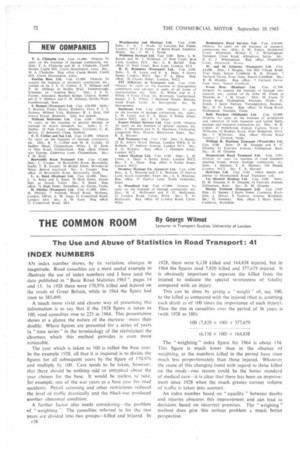THE COMMON ROOM
Page 74

If you've noticed an error in this article please click here to report it so we can fix it.
By George Wilmot
Lecturer in Transport Studies, University of London
The Use and Abuse of Statistics in Road Transport : 41 INDEX NUMBERS
AN index number shows, by its variation, changes in magnitude. Road casualties are a most useful example to illustrate the use of index numbers and I have used the data published in "Basic Road Statistics 1965", pages 14 and 15. In 1928 there were 170,976 killed and injured on the roads of Great Britain, while in 1964 the figure had risen to 385,499.
A much more vivid and clearer way of presenting this information is to say that if the 1928 figure is taken as 100, road casualties rose to 225 in 1964. This presentation shows at a glance the nature of the increase----more than double. Where figures are presented for a series of years (a " time series" in the terminology of the statistician) the clearness which this method provides is even more noticeable.
The year which is taken as 100 is called the base year. In the example 1928, all that it is required is to divide the figures for all subsequent years by the figure of 170,976 and multiply by 100. Care needs to be taken, however. that there should be nothing odd or untypical about the year chosen for the base. It would be useless to take. for example, one of the war years as a base year for road accidents. Petrol rationing and other restrictions reduced the level of traffic drastically and the black-out produced another abnormal condition.
A further factor also needs considering-the problem of "weighting ". The casualties referred to for the two years are divided into two groups-killed and injured. In 4738 1928, there were 6,138 killed and 164,838 injured, but in 1964 the figures read 7,820 killed and 377,679 injured. It is obviously important to separate the kilted from the injured to indicate the special seriousness of fatality compared with an injury.
This can be done by giving a " weight " of, say 100, to the killed as compared with the injured (that is, counting each death as of 100 times the importance of each injury). Thus the rise in casualties over the period of 36 years is (with 1928 as 100): 100 17,820 x 100) + 377,679 (6,138 x 1001 + 164,838 The " weighting " index figure for 1964 is about 154. This figure is much lower than in the absence of weighting, as the numbers killed in the period have risen much less proportionately than those injured. 'Whatever the cause of this changing trend with regard to those killed on the roads-one reason could be the better standard of medical care-it is clear that there has been an improvement since 1928 when the much greater current volume of traffic is taken into account.
An index number based on " equality " between deaths and injuries obscures this improvement and can lead to decisions based on incorrect premises. The " weighing " method does give this serious problem a much better perspective.
























































































































